Viola grisea (Fernald) H.E.Ballard
Common names:
Great Lakes Violet
Synonyms:
Viola grisea (Fernald) H.E.Ballard, comb. nov.; Viola septentrionalis Greene var. grisea Fernald, Rhodora 37: 301, pl. 375. 1935; Viola novae-angliae House subsp. grisea (Fernald) Gil-ad, Boissiera 53: 68. 1997; Viola sororia Willd. var. grisea (Fernald) L.E.McKinney, J. Bot. Res. Inst. Texas 4(1): 226. 2010. TYPE: USA. Michigan. Schoolcraft Co., dry sandy plain near Driggs, 2 Jul 1934, M. L. Fernald & H. S. Pease 3430 (HOLOTYPE: GH00032648!, ISOTYPES: MICH!, US!)
Description:
Acaulescent rosulate perennials from thick rhizome, ≤ 27 cm tall; foliage and peduncles green, upper surface of leaf blades often darker, lower surface commonly purple tinged, moderately to densely hirsute; stipules free, irregularly glandular-fimbriate; leaves ascending, leaf blades undivided, largest ≤ 89 × 51 mm, narrowly triangular-ovate in chasmogamous flower, scarcely broadening in fruit, base subcordate to deeply cordate, margins crenate to serrate with 10–(avg. 14)–21 teeth on each side, ciliate, apex acuminate to narrowly obtuse; chasmogamous peduncle held among or above the leaves, moderately to densely hirsute especially in the lowest 2/3; chasmogamous flower ≤ 25 mm; calyx glabrous or pubescent, ciliate to apex, often with long hairs; lowest sepals ovate, 2.7–3.8 mm wide, length:width ratio ≤ 2.1, broadly rounded; auricles short to somewhat prominent and entire, elongating in fruit to 2 mm; corolla blue to purple, throat white; spur short-globose; lateral and spurred petal densely bearded with filiform to narrowly linear hairs, spurred petal densely bearded; chasmogamous capsule green; cleistogamous flowers produced after chasmogamous, the peduncle prostrate, arching just before dehiscence, shorter than petioles; cleistogamous capsule 5–11 mm, green drying to tan with purple spots or blotches, glabrous; seeds 1.6–2.0 × 1.0–1.4 mm, medium yellow-brown to dark brown, unspotted.
Similar species:
The most similar species likely to be confused with the present violet are Viola novae-angliae and Viola septentrionalis, Borealiamericanae violets with pubescent foliage, undivided narrowly ovate or narrowly ovate-triangular leaf blades the largest of which are longer than broad (at least some of the time), oblong to ovate ciliate obtuse to rounded sepals, prominent auricles, a densely bearded spurred petal, a heavily spotted or blotched cleistogamous capsule on a prostrate peduncle, and unspotted brown seeds. This species differs from V. novae-angliae in its moderately to densely hirsute petioles, leaf blades and peduncles, commonly proportionally broader leaf blades with more numerous marginal teeth, and commonly broader densely ciliate sepals; and from V. septentrionalis by its consistently narrowly ovate-triangular leaf blades, consistently rounded ciliate sepals, and more broadly ovoid unspotted seeds.
Ecology:
Thin soil on mostly granitic rock outcrops and other acidic rock substrates along rivers, moist sand of lakeshores and borders of mesic sand prairies, rarely on limestone alvar (in c. Upper Peninsula of MI, se. ON).
Distribution:
Western Great Lakes region, n. MI to se. MB, south to c. WI and c.MN, disjunct in se. ON.
Rarity:
State listed in MI.
Phenology:
Chasmogamous flower May–June, chasmogamous fruit June, cleistogamous fruit July–August.
Affinities:
This species belongs to the Acaulescent Blue Violet lineage, sect. Nosphinium W.Becker, subsect. Boreali-Americanae (W.Becker) Gil-ad, in the Sororia species group.
Hybrids:
Occasional specimens with intermediate foliage characteristics were inferred as hybrids with V. sororia during field studies in Minnesota and Wisconsin leading to the publication by Ballard and Gawler (1994). Gil-ad (1995, 1997) reported a hybrid with V. nephrophylla in Arootstook Co., ME. No information is available on hybrid reproduction.
Comments:
The V. novae-angliae species complex was collectively treated as V. novae-angliae by Brainerd (1921b), Brainerd Baird (1942), Alexander (1963), Russell (1965), Scoggan (1978), Ballard and Gawler (1994), Ballard (1995), Haines et al. (2011), and Little and McKinney (2015). Fernald (1950) circumscribed V. novae-angliae to be a geographically bimodal taxon including northeastern populations and western Great Lakes populations, but he segregated northern Michigan V. septentrionalis var. grisea from Driggs area, Schoolcraft County, that he had described a year before (Fernald 1949). In studying the V. novae-angliae complex and V. septentrionalis, Gil-ad (1995, 1997, 1998) concluded that V. septentrionalis var. grisea Fernald shared many vegetative and reproductive traits as well as micromorphological features of petal trichomes and seed coats with V. novae-angliae, and he transferred grisea to the latter species. He documented a number of differences between the grisea taxon (to which he added specimens from Crawford County in Michigan's Lower Peninsula) and typical V. novae-angliae. On the basis of few study samples from the western Upper Great Lakes range of the complex, Gil-ad made the new combination V. novae-angliae subsp. grisea to accommodate the latter and referred all other western Great Lakes populations plus northeastern populations to V. novae-angliae subsp. novae-angliae. Voss and Reznicek (2012) have followed this treatment. In the last several years I have studied numerous specimens from several herbarium collections from the western Great Lakes region, New England and maritime Canada (including all relevant sheets examined by Gil-ad), as well as my own field-collected chasmogamous flowering specimens from Crawford County, and chasmogamous flowering and cleistogamous fruiting population samples from northern Minnesota provided by Lynden Gerdes. The much increased sampling of specimens and study material (but still few fruiting specimens of northeastern populations) allowed me to extend cumulative sbservations and conduct morphometric studies of leaves, chasmogamous flowers, cleistogamous capsules and seeds. Results obliterated the distinctions proposed by Gil-ad between Crawford and Schoolcraft County subsp. grisea versus material from the rest of the western Great Lakes region and have compelled me to treat all specimens from the western Upper Great Lakes region under the grisea taxon. The 1971 specimen from Schoolcraft County (D. Henson 53) previously assigned to V. novae-angliae exhibited macromorphological features verging toward V. nephrophylla and was reinterpreted as a hybrid between V. grisea and V. nephrophylla. Broader comparisons between Great Lakes grisea and northeastern V. novae-angliae sensu stricto yielded some statistically significant quantitative differences, a few qualitative distinctions, and a number of additional tendencies that collectively separated the two geographically distinct sets of populations. Gil-ad's micromorphological studies provided additional indications that the two taxa could not be considered morphologically identical at the species level. Label information, field studies and floristic treatments also suggested a substantial degree of habitat differentiation, with grisea occupying primarily circumneutral to somewhat acidic substrates and novae-angliae inhabiting primarily alkaline substrates. The two taxa are treated here as different evolutionary species, with the unpublished combination at species rank used for the regionally endemic western Great Lakes taxon. The common name of Great Lakes Violet is proposed as an appropriate moniker.
Literature Cited:
Alexander, E. J. 1963. Violaceae. In Gleason, H. A., The new Britton and Brown illustrated flora of the northeastern United States and adjacent Canada. Hafner Publishing Co., Inc., New York, NY. 552-567.
Ballard Jr., H. E. 1995 ["1994"]. Violets of Michigan. Michigan Botanist 33: 131-199.
Ballard Jr., H. E., and S. C. Gawler. 1994. Distribution, habitat and conservation of Viola novae-angliae. Michigan Botanist 33: 35–52.
Brainerd, E. 1921b. Violets of North America. Vermont Agricultural Experiment Station Bulletin 224: 1–172.
Brainerd Baird, V. 1942. Wild violets of North America. University of California Press, Berkeley, CA.
Fernald, M. L. 1949. Rhizome characters in and minor forms of Viola. Rhodora 51: 51-57, plates 1134-1136.
Fernald, M. L. 1950. Violaceae. In Gray’s Manual of Botany, 8th ed. American Book Company, New York, NY. 1022-1042.
Gil-ad, N. L. 1995. Systematics and evolution of Viola L. subsection Boreali-Americanae (W. Becker) Brizicky. Ph.D. dissertation. University of Michigan, Ann Arbor, MI.
Gil-ad, N. L. 1997. Systematics of Viola subsection Boreali-Americanae. Boissiera 53: 1–130.
Gil-ad, N. L. 1998. The micromorphologies of seed coats and petal trichomes of the taxa of Viola subsect. Boreali-Americanae (Violaceae) and their utility in discerning orthospecies from hybrids. Brittonia 50: 91–121.
Gleason, H. A., and A. Cronquist. 1991. Violaceae. In Manual of vascular plants of northeastern United States and adjacent Canada, 2nd ed. New York Botanical Garden, Bronx, NY. 157-163.
Haines, A., E. Farnsworth, and G. Morrison. 2011. Violaceae. In Flora Novae Angliae. Yale University Press, New Haven, CT. 873-886.
Little, R. J., and L. E. McKinney. 2015. Violaceae. In Flora of North America: Cucurbitaceae to Droseraceae, 106. Oxford University Press, New York, NY.
McKinney, L. E. 1992. A taxonomic revision of the acaulescent blue violets (Viola) of North America. Sida, Botanical Miscellany 7: 1–60.
Russell, N. H. 1965. Violets (Viola) of the central and eastern United States: An introductory survey. Sida 2: 1-113
Scoggan, H. J. 1978. Violaceae. In Flora of Canada, Part 3–Dicotyledoneae (Saururaceae to Violaceae). National Museums of Canada. Ottawa, Canada. 1103-1115.
Voss, E. G., and A. A. Reznicek. 2012. Violaceae. In Field manual of Michigan flora. The University of Michigan Press, Ann Arbor, MI. 913-922.

Chasmogamous flowering habit by Peter M. Dziuk, "Minnesota Wildflowers" website
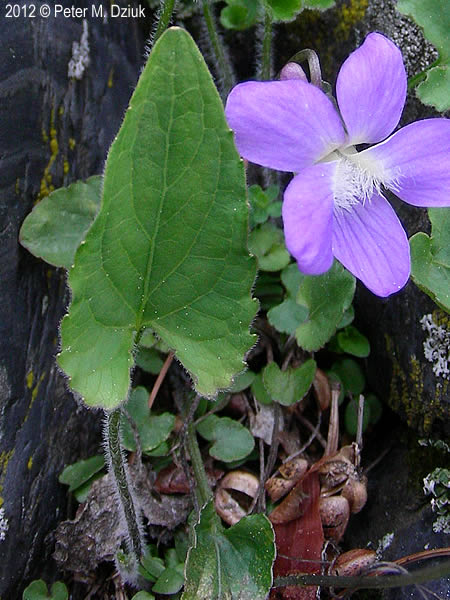
Leaf during chasmogamous flower by Peter M. Dziuk, "Minnesota Wildflowers" website
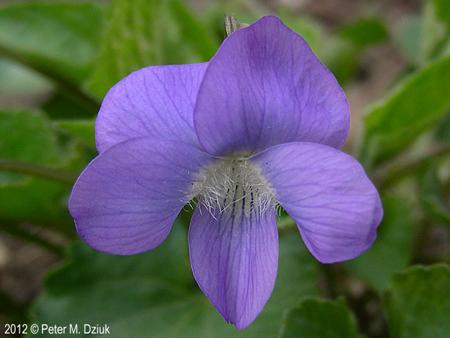
Chasmogamous flower front view by Peter M. Dziuk, "Minnesota Wildflowers" website

Chasmogamous flower profile view by Peter M. Dziuk, "Minnesota Wildflowers" website
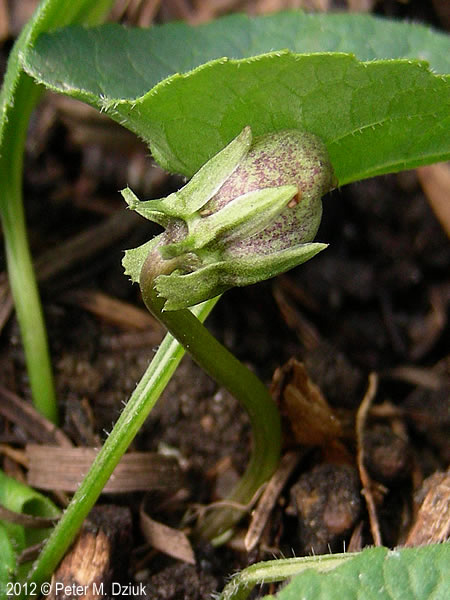
Cleistogamous fruit by Peter M. Dziuk, "Minnesota Wildflowers" website
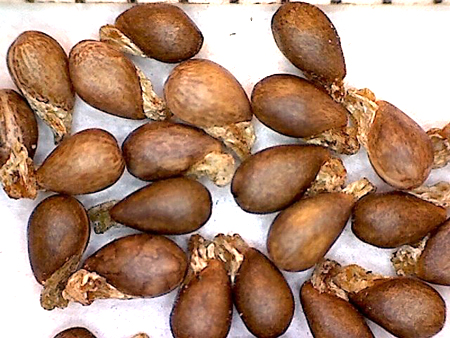
Seeds from herbarium specimen: Transplanted from WI, Mercer, Dr. Ogden donor, E. Brainerd 89 (NY)
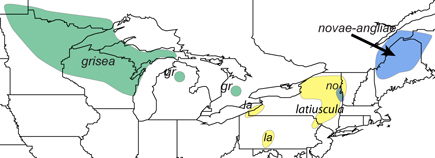
Map of northern members of the Sororia species group by Harvey Ballard